When working on firearms, you need several types of punches to remove different types of pins. Having a large selection of gunsmithing punches made from steel, brass, and plastic will ensure you have the right tool for the job, making any modifications or repairs you attempt much easier. It will also help prevent damage to your firearm. Gunsmithing punches are made of different types of materials for a reason. Each material is good for some situations, while it may be completely inappropriate for others.
The following article will detail some of the things I have learned about gunsmithing punches while working on my own guns. I am not a professional gunsmith, and I don’t pretend to be one. However, I have learned quite a bit working on my own firearms, including the importance of using the right tools for the job. The information below should help you understand the different types of gunsmithing punches, their uses, and why they are made from different types of materials.
Steel Punches
Most gunsmithing punches are made of steel. Steel punches are indispensable when working with certain types of pins, such as taper pins and roll pins. Unfortunately, they are also more likely to gouge or scratch your firearm than punches made with different materials.
When using steel punches, cover the area around the pin you are driving with masking tape to reduce the chance of scratching your firearm’s finish if the punch slips. While steel gunsmithing punches aren’t perfect, there are times when they are the best tool for the job.
Related: Companies that Make the Best Gunsmithing Tools
Brass Punches
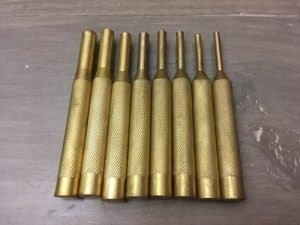
Brass punches are the type of punch you should use most of the time when making repairs or modifications to your firearms. They are much softer than steel, which means they are less likely to damage firearm parts. Since most firearm parts are made of steel, a brass punch cannot gouge or scratch them, although it can still damage certain finishes if you aren’t careful.
One downside to using brass punches is that they may not be able to remove stubborn pins. Since they are so soft, they will likely deform against a stuck pin. This will prevent damage to your firearm, but you can waste a lot of money going through brass punches. A good approach is to try removing the pin with a brass punch, and if it won’t move, then try a steel punch. You want to remove pins using the least amount of force and the safest tools possible.
(affiliate link)
Plastic
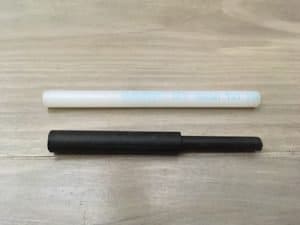
Plastic gunsmithing punches work well to push out takedown pins, like the ones found on AR-style rifles. They also work well to drift sights, as long as the sights aren’t too stubborn. Although they cannot handle heavy-duty work, it is very difficult to damage a firearm and most finishes with a plastic punch.
Plastic gunsmithing punches are most commonly made of nylon or Delrin. Both of these materials are durable but non-marring. The only danger of using plastic punches is that they can become embedded with small particles, like dirt and metal shavings, that could cause scratches. This problem is easily avoidable by making sure that the ends of your nylon or Delrin punches are clean.
Types of Gunsmithing Punches
Drive Pin Punches
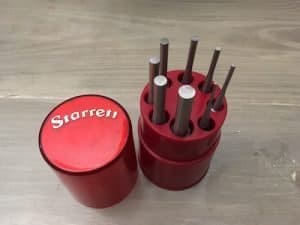
The most common type of punch is the drive pin punch. Drive pin punches are solid pieces of metal that have a handle which tapers into a shaft. The shaft remains the same diameter all the way to the end of the punch, which is flat. Drive pin punches come in several lengths and diameters to suit different sizes of pins. They can be made of either brass or steel.
Starrett’s 8-piece drive pin punch set is my choice for the best general-purpose gunsmithing punch set. They get excellent reviews and my set has held up very well. You can get your own set by clicking here.
Roll Pin Drive Punches
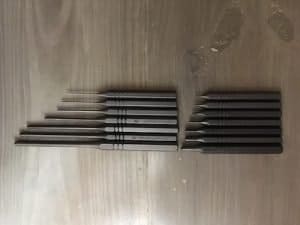
These are similar to standard drive punches but have a round ball-shaped end that prevents the roll pin from caving in when being driven in and out of a firearm. They are long enough for the end to pass all the way through most assemblies such as frames and slides. Although brass roll pin drive punches are available, I recommend getting ones made of steel. The sharp edges of roll pins will likely deform brass roll pin punches after very little use.
The best roll pin punches are produced by Grace USA. You can find them by clicking here.
Roll Pin Starter Punches
These are shorter versions of regular roll pin drive punches. Like other roll pin punches, they have a round ball-shaped end to prevent damage to the pin. However, starter punches are much shorter than standard roll pin punches. This makes them much harder to bend which is helpful if you have to remove a stubborn roll pin.
As with the full-sized roll pin punches, the best starter punches are produced by Grace USA. You can find them by clicking here.
Roll Pin Holders

One of the most difficult parts of working with roll pins is getting them into their hole in the first place. Roll pin holders make this much easier. They have a concave end which causes the roll pin to constrict when pressure is placed upon it. This allows you to insert the roll pin into the firearm without having to use pliers to squeeze the roll pin. After you use a roll pin holder to insert the roll pin partially, drive it in the rest of the way with a regular roll pin punch or roll pin starter punch.
Starter Punches (Solid Punches)
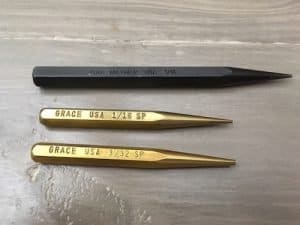
Starter punches are spike-shaped punches with a wide striking end that tapers down to a blunt point at the other end. They are also referred to as solid punches. Their design makes them strong and difficult to bend. It also allows a lot of energy to be directed into a very small point, making starter punches very effective at removing stubborn pins. Like drive pin punches, they can be made of either brass or steel. However, for really stubborn pins, a steel starter punch would likely be a better option.
Nail Sets
Nail sets are the punches carpenters use to sink finish nails below the surface of wall trim boards. However, they are also good starter punches for pins with rounded heads, especially if they are protruding from the firearm. Drive punches with flat ends tend to deflect off of the pin and can gouge your firearm. A nail set is less likely to have this problem due to the concave shape of its tip. You can use a nail set punch to get the pin started and finish removing it with a regular drive punch after the tip of the pin is below the edge of the hole.
Center Punches
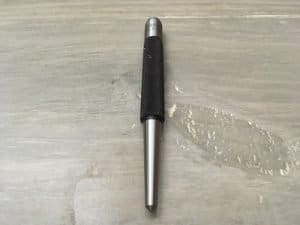
A center punch is different from other types of punches in that it isn’t normally used to drive pins. They are most commonly used when drilling in metal to mark where the center of a hole should be. Center punches have a sharp point at the end which makes a small dimple in a work surface when it is struck with a hammer. The dimple indicates where the hole needs to be drilled and also helps prevent the drill bit from “walking”. Center punches are commonly used on AR-style firearms to stake the castle nut to prevent it from loosening while firing.
When to Use Steel Gunsmithing Punches
Taper pins
A taper pin is one that is larger at one end than it is at the other. Since they “wedge” in place, they hold really well and are incredibly difficult to remove. The most common use of taper pins is to hold the front sight post/gas block into place on AR-pattern rifles. When removing taper pins, you will need to start with a steel starter punch.
Stubborn or Long Pins
Some pins will not budge if you try to drive them out with a brass punch. The harder you hit, the more you will deform your punch. For pins like these, it is best to use a steel starter punch and then finish removing it with a steel drive punch.
Roll Pins
A roll pin is a piece of flat spring steel that has been rolled into a round shape. They look like a tiny cylinder with a small gap in the middle. Removing and reinserting roll pins requires the use of specialized punches, which were mentioned above. If you are building a gunsmithing punch kit for pistols or AR-style rifles, you will need a set of each type of roll pin punch.
When to Use Brass Punches
Antique or Valuable Firearms
Brass punches should be your go-to tools if you need to remove pins from high-value or heirloom firearms. As mentioned before, they are far less likely to cause damage, which is especially important on firearms that need to be kept in pristine condition.
Drifting Sights
Brass punches are a much better choice than steel punches when adjusting or installing iron sights. They will not dent, scratch, or gouge iron sights. However, any plastic sights should be drifted using a plastic drift punch.
Buying and Use Tips for Gunsmithing Punches
Best Brands for Gunsmithing Punches
Although many manufacturers produce gunsmithing punches, I have found that Grace USA and Starrett make some of the best. Grace USA produces a full line of gunsmithing tools including several types of punches, screwdrivers, and hammers. Starrett, on the other hand, produces precision measuring and hand tools, including some of the best calipers and punches on the market. Other good gunsmithing punch manufacturers include Mayhew and Brownells.
Good gunsmithing punches, like the ones from the manufacturers mentioned above, are machined from solid pieces of steel or brass. Cheaper punches are made from cast metal. These are easy to spot due to the casting marks on the side. Although cast metal can be strong, most cheap gunsmithing punches are not made using the best production methods. That’s why they are cheap. As such, they will bend or break much easier than those that are machined from a solid piece of metal. Punches such as this are far more likely to gouge or scratch a firearm.
Buy Duplicates
When you are working on your firearms, it is very likely that you will bend or break some punches, especially the smaller ones. I like to keep a couple of extra 1/16 inch punches lying around in case my primary one breaks. If you buy your punches from Brownells or good manufacturers, they should replace them under warranty. However, keeping spares on hand will allow you to keep working even if your tool breaks.
Don’t Let the Ends Mushroom
After you have used your gunsmithing punches, the ends will start to deform. Most people call this “mushrooming” due to what it looks like when this occurs. These rough edges can occur on both ends of a punch. They are bad because they reduce the punch’s effectiveness and increase the likelihood of damaging your firearm while using the punch.
Avoid excessive damage to your punches by keeping them straight as you are using them. Also, make sure that your hammer lands flat on the end of the punch. If your gunsmithing punches start to show signs of mushrooming, take a file and remove the rough edges from them. Your goal is to get the punch as close as possible to its original shape. If either end of the punch is uneven after you remove the rough edges, use your file again to square the ends. Your punches should be flat and round on both ends.
Use a Bench Block
A bench block is an essential tool that will make using gunsmithing punches much easier. Bench blocks hold your workpiece steady and have holes in them that allow pins to pass through as you are driving them out.
If you don’t have a bench block, you can use a thick roll of duct tape or a small piece of 2×4 with holes drilled in it. Thick rolls of duct tape work best on odd-shaped items since they compress slightly and mold to the shape of what you are working on. The tape’s adhesive also helps prevent whatever you are working on from slipping as you are working on it. However, since duct tape is much softer than a regular bench block, it will absorb some of the energy each time you strike the punch with a hammer.
Use a Steady Work Surface
Having a solid workbench or other work surface is incredibly important when using gunsmithing punches. As you strike the punch with a hammer, you want as much of that energy as possible to transfer from the punch to the pin you are attempting to remove or insert. If you have a wobbly workbench, it will move each time that you strike the punch. This movement steals energy that could have gone into the pin. Using unstable work surfaces also increases the chances that your hammer will miss the punch and hit the firearm or the punch will slip and cause a scratch or gouge.
When using gunsmithing punches, also avoid placing your workpiece or bench block on cleaning mats or other soft surfaces. While mats such as these do a good job absorbing solvents and preventing scratches to your firearms, they also absorb the energy from hammer blows, greatly reducing their effectiveness in removing pins. Set your cleaning mat aside, and let your bench block rest directly on the hard workbench top.
Conclusion
Although having a wide array of gunsmithing punches is important, there are many other tools that you need if you are going to work on guns. My article, Essential Gunsmithing Tools, covers the basic tools you will need to get started.
If you are interested in gunsmithing, take a look at these articles also:
Brownell’s Magna-Tip Screwdriver Set Review
How to Build a Spare Parts Kit for Your Guns
Cheap Tools to Make Gunsmithing Easier
How to Repair a Damaged Gun Screw
Ruger 10/22 Sight Removal and Replacement
Essential Gun Cleaning Tools
How to Clean a Semi-Automatic Pistol
Essential Reloading Equipment: Introduction to Reloading

